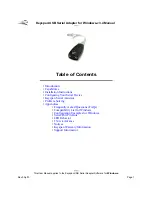
ZyXEL G-302 v3 User’s Guide
Appendix C Wireless Security
71
WPA(2)
Wi-Fi Protected Access (WPA) is a subset of the IEEE 802.11i standard. WPA2 (IEEE
802.11i) is a wireless security standard that defines stronger encryption, authentication and
key management than WPA.
Key differences between WPA(2) and WEP are improved data encryption and user
authentication.
If both an AP and the wireless clients support WPA2 and you have an external RADIUS
server, use WPA2 for stronger data encryption. If you don't have an external RADIUS server,
you should use WPA2-PSK (WPA2-Pre-Shared Key) that only requires a single (identical)
password entered into each access point, wireless gateway and wireless client. As long as the
passwords match, a wireless client will be granted access to a WLAN.
If the AP or the wireless clients do not support WPA2, just use WPA or WPA-PSK depending
on whether you have an external RADIUS server or not.
Select WEP only when the AP and/or wireless clients do not support WPA or WPA2. WEP is
less secure than WPA or WPA2.
Encryption
Both WPA and WPA2 improve data encryption by using Temporal Key Integrity Protocol
(TKIP), Message Integrity Check (MIC) and IEEE 802.1x. WPA and WPA2 use Advanced
Encryption Standard (AES) in the Counter mode with Cipher block chaining Message
authentication code Protocol (CCMP) to offer stronger encryption than TKIP.
TKIP uses 128-bit keys that are dynamically generated and distributed by the authentication
server. AES (Advanced Encryption Standard) is a block cipher that uses a 256-bit
mathematical algorithm called Rijndael. They both include a per-packet key mixing function,
a Message Integrity Check (MIC) named Michael, an extended initialization vector (IV) with
sequencing rules, and a re-keying mechanism.
WPA and WPA2 regularly change and rotate the encryption keys so that the same encryption
key is never used twice.
The RADIUS server distributes a Pairwise Master Key (PMK) key to the AP that then sets up
a key hierarchy and management system, using the PMK to dynamically generate unique data
encryption keys to encrypt every data packet that is wirelessly communicated between the AP
and the wireless stations. This all happens in the background automatically.
Deployment Difficulty
Easy
Hard
Moderate
Moderate
Moderate
Client Identity Protection
No
No
Yes
Yes
No
Table 26
Comparison of EAP Authentication Types
EAP-MD5
EAP-TLS
EAP-TTLS
PEAP
LEAP
Summary of Contents for G-302 V3
Page 1: ...ZyXEL G 302 v3 802 11g Wireless PCI Adapter User s Guide Version 4 00 Edition 1 10 2008...
Page 2: ......
Page 6: ...ZyXEL G 302 v3 User s Guide 6 Preface...
Page 19: ...ZyXEL G 302 v3 User s Guide Table of Contents 15 Index 75...
Page 20: ...ZyXEL G 302 v3 User s Guide 16 Table of Contents...
Page 24: ...ZyXEL G 302 v3 User s Guide 20 List of Tables...
Page 31: ...ZyXEL G 302 v3 User s Guide Chapter 1 Getting Started 27 Figure 9 ZyXEL Utility Link Info...
Page 32: ...ZyXEL G 302 v3 User s Guide 28 Chapter 1 Getting Started...
Page 38: ...ZyXEL G 302 v3 User s Guide 34 Chapter 2 Wireless LAN Network...
Page 72: ...ZyXEL G 302 v3 User s Guide 68 Appendix B Management with Wireless Zero Configuration...







































